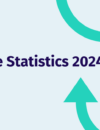
In 2021, there were 390,000 more disabled people in employment in the UK than in 2019, despite the drop in numbers between those years caused by the Covid-19 pandemic. We’re seeing progress when it comes to disability and employment – but still, the barriers disabled people face in the world of work are plentiful.
Gov.uk states that 1 in 5 of the working-age population is disabled, and more people are reporting to have a disability or long-term health condition than just under a decade ago. But while such a large percentage of the population is disabled, the disability gap at work is still disproportionate. Disabled people are more likely than non-disabled people to be temporarily away from work, and the “disability employment rate was 52.7% in 2021, compared to 81.0% for non-disabled people”.
There are so many factors that mean disabled people face complexities and barriers when looking for, or keeping, a job. Age, ethnicity, class, mental health and geographical location can be additional factors, and add to the challenges encountered, too.
You’re legally obligated to ensure nobody faces discrimination in the workplace, but it’s also morally right and undeniably better for your organisation to ensure your office is as accessible as possible. This will not only break down the barriers that sometimes prevent disabled people from working, but will also allow your business to benefit from the ideas, experience and strengths of the disabled community.
So what can you do to help close the gap?
Making space
Making your office and work spaces physically accessible ensures that all employees and visitors can access, use and make the most of the facilities available.
When we talk about making your space accessible, you’ll most likely think about changing the layout and access routes first. Ensuring your office has enough space for wheelchairs to move around, and installing step-free access options like ramps and lifts, are some of the most basic ways you can do this. However, installing clever lifts, for example, is pointless if they’re not maintained and kept running, and ramps should be usable (just take a look at this viral TikTok post of a wheelchair user trying to use a steep ramp). If you’re going to do it, do it properly.
Accessible spaces aren’t just about wheelchair access. Consider clear signage, braille options and the quality of lighting for people with visual impairments, medical conditions or neurodiversities. Look at where light switches and fire alarms are installed, and whether they can be accessed by all. Invest in adjustable desks and specialist equipment – or at least make it easy for team members to request kit when needed. Ensure you offer blue badge parking options, and, if you have a reception desk, check that it’s at an accessible or adjustable level allowing all visitors to easily speak to your reception team face-to-face.
Remember not to focus only on the office space itself, but all areas accessed by your team. We’re talking kitchen spaces, social areas and toilets, too.
Talking tech
It’s not all about the physical space: you can make changes to the software and technology you use. Assistive technology can be essential for creating an inclusive work environment. Speech recognition equipment devices, braille keyboards, listening devices and sign language apps can be essential for enabling everyone to communicate properly.
Accessible technology is something that Accenture does really well, for example. Their IT accessibility programme is focused on ensuring that 100% of their tech is ‘compliant with accessibility standards’. It’s really worth checking out what other organisations are doing to see how you can keep up.
Equality education
Continually improving and educating yourselves is vital for a truly inclusive workspace, too, and we’re huge advocates for investing in up-to-date, comprehensive training. Make sure everyone is aware of accessibility requirements and what’s expected within your team, and create and regularly update the disability discrimination and accessibility section of your employee information packs.
It’s important you also educate your team about ableist or discriminatory language, and how this can impact and harm the disabled community. Changing how you talk as a team is essential for creating a truly inclusive environment.
Google does great things to ensure accessibility is a priority within the organisation. Among their many activities, their Central Accessibility Team trains their community on accessibility best practices. These kinds of approaches should be prioritised and continually implemented. Consider hiring specialists or experts to lead this work.
Creating a stress-free environment
Loud, busy, chaotic offices are, to many, a sign of productivity. People talk about the buzz of being in a collaborative space – but have you ever considered how these intense environments can impact the health and wellbeing of others?
Many people might find these kinds of workspaces overwhelming and overstimulating. For example, noisy offices will make hearing conversations or phone calls even more challenging for those with hearing impairments. Whatsmore, neurodivergent members of the team, and those with mental health difficulties who may be triggered by loud noises, stressful surroundings and bright lights, will be excluded and impacted if your office is unwelcoming.
Create quiet spaces people can use if they feel overwhelmed, or need some time to themselves. Explore lighting options to avoid an overly bright environment (while not compromising on visibility), and look at how you can reduce unnecessary noise.
Some companies also choose to provide wellbeing opportunities such as yoga, meditation sessions and similar, which can be soothing. Just be sure to opt for activities that everyone can join in with, regardless of physical ability.
Feeling flexible
We’ve talked a few times about the benefits of remote working culture. While its popularity is now seemingly fluctuating in the corporate world, it’s essential that you offer the option to work from home to your team. When employees can work from home or an alternative location, they can manage their disabilities or additional needs as they need to, in a familiar place. By not forcing them into the office, you’re ensuring they have access to the equipment they need, and reducing the stress or discomfort caused by commuting.
You’ll be opening up opportunities to a lot of people who may be restricted to their homes or unable to travel easily – and who knows what talents and skills they’ll bring to your team!
Flexible hours can also be a blessing; allowing your team to work around appointments, treatments, periods of poor health or any other requirements will once again make it easier for them.
Bettering on a budget
Of course, making big changes to physical office spaces isn’t always possible or realistic. Unless you’re a big company or organisation, you’ll be limited by rental agreements, and it’s unlikely changing the layout of buildings, rooms and access points will be easy. Many startups work in co-working spaces, too, and so will be sharing offices with other organisations.
There are, thankfully, smaller changes you can make too, to improve the inclusivity of your working space. Many of these will be inexpensive, straightforward and effective!
Consider the layout of meeting spaces, and encourage colleagues with visual or hearing impairments to sit closer to the front in presentations, or ensure all attendees are able to clearly see other colleagues’ faces for lip-reading purposes. Reduce excessive noise, explore lighting options, use subtitles or transcriptions in online calls, invest in software and communicate with teams in a range of mediums (offering both visual and audio options).
There’s always more that can be done. If you ever need inspiration, look to see what similar organisations are implementing within their workplaces…or ask your team to find out what they really need. Listen to the experts.
At Druthers, it’s our mission and our passion to empower organisations to find the best person to make an impact on their work, from a diverse shortlist of remarkable talent. Get in touch with us to find out how your business can make a positive change to your hiring and retention processes.





